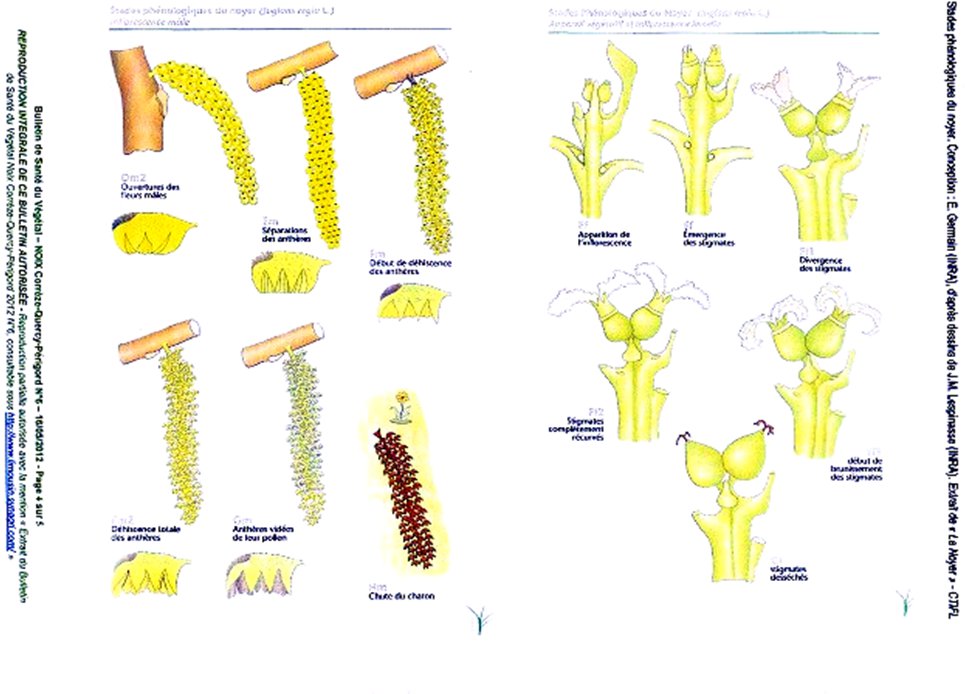The main pests and diseases to consider are:
- bacteriosis (Xanthomonas campestris pr. juglandis)
- Anthracnose (Gnomonia leptostyla)
- Codling moth (Cydia pomonella)
- Moth (Amyelois transitella)
- walnut fly (Rhagoletis & nbsp; complete)
- yellow aphid (Chromaphis juglandicola)
Other diseases, especially if they affect the roots, as Armillaria and Phytophthora, are difficult to solve and require consulting a technician to determine the cause, and the appearance of spots and exudates in the trunk, due often to soil problems, irrigation, etc.
Bacteriosis and Anthracnose, caused by the bacterium the first and second fungus are sometimes hardly distinguishable with the naked eye and require laboratory study. Generally the deeper causes bacterial spot, while anthracnose is very superficial The appearance of both is favored by moisture and the time of appearance on leaves and fruit coincides with the early stages of development, in spring. His control is not easy in humid climates. It is less scary in climates with dry springs.
Treatments
1st Pre-Sprouting
Treatment with copper oxychloride as hydroxide or cuprous oxide. The dose should not lower adult trees of 5 kg of copper metal per hectare, which reptresenta between 7 and 10 kg of commercial product depending on its composition. It is recommended that you add mancozeb or maneb, at doses of 2.5 Kg / Hawhich improves the bactericidal action of copper and is effective against anthracnose.
2nd budding
The same treatment as above. Usually about 15-20 days separately.
3rd start Blooming & nbsp;
Same as above. Range 15-20 days.
4th Blooming
The same treatment, reducing the dose by 50%
5th Final flowering
Like the first three. Is recommended add Myclobutanil (Systhane or equivalent), anthracnose very effective because it requires the presence systemic leaves to be absorbed
6th formed Nuts
Is recommended repeat the treatment may add Tebuconazol No. 4 if there necrosisapical problems in previous years, due to alternaria, fusarium, etc.
From the end of May, is not easy to have these diseases and infections if present, are from earlier contamination.
Carpocapsa
It is essential monitoring the parcel to determine the life cycle of this insect. The capture of three or more adults per week requires making treatment. Licensed products to this date, are Insegar, Dimilin, phosmet, Clorpiriphos, Metolfenocide (Runer), Karate, etc.
You need to repeat the treatment every time more than three adults are captured in a week if the period of effectiveness of the product used, which is variable for each of them.has elapsed
The first treatment, depending on the area and spring temperatures usually between 15 April and early May.
Currently it is very advisable to employ the technique of "sexual confusion" consisting of placing a pheromone dispensers (puffer), which are released codling moth pheromone, which prevent the detection of females by males and therefore mating. It is a very effective and highly ecological system. The charge of the "puffer" lasts all year.
walnut moth
In fact is an insect that comes from the carob tree. The damage occurs close to harvest time in nuts still on the tree and even on the floor. It is a lepidopteran damage which is sometimes confused with codling moth, but is hardly detectable in the collection. The larva develops inside the nut.
It is possible to control its life cycle through pheromone monitoring to determine if and when to treat, because it is not detected in all producing areas walnut. If necessary it can be treated with phosphorus products used to control codling moth.
Fly walnut
Of recent appearance on plantations in Italy and France, and extended to plantations in Girona, causes major damage during the summer. It is like the cherry fruit fly and fruit Diptera. The adult deposits its eggs on the bark of green walnuts and the larvae open galleries on it, causing decay and rot. About this rot fungi that cause fruit drop are developed.
The placement of sheets of yellow plastic with glue, can detect the presence and determine the treatment. Pyrethrins are effective, despite their low persistence. Phosmet which is simultaneously effective against other insects may also be used (codling moth, etc.)
Yellow Aphids
appears in summer. Their exudates are breeding grounds for mold and, in severe attacks, can cause defoliation.
usually sufficient treatment with imidacloprid for the entire campaign.
Vegetative Stages of walnut (INRA)
male flower Female flower
